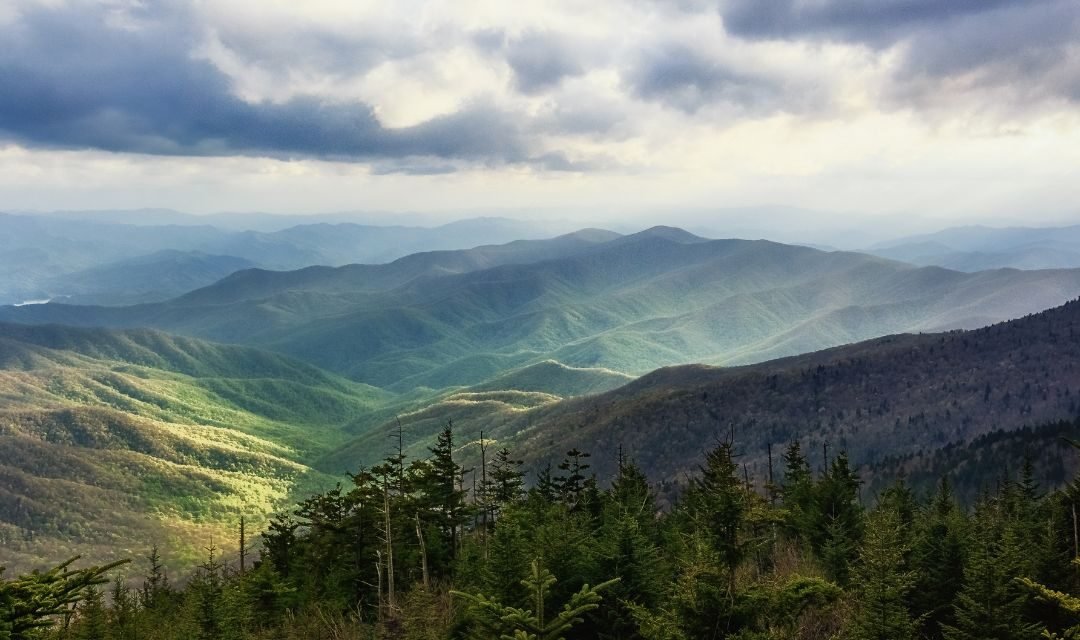Overview of Great Smoky Mountains National Park
Great Smoky Mountains National Park, spanning the border between North Carolina and Tennessee, is renowned for its diverse plant and animal life, stunning landscapes, and rich cultural history. The park, established in 1934, encompasses over 522,000 acres and is the most visited national park in the United States. The Smokies, as they are affectionately known, boast ancient mountains, lush forests, and cascading waterfalls, offering visitors a truly unforgettable experience.
Great Smoky Mountains National Park Location
Great Smoky Mountains National Park straddles the border between North Carolina and Tennessee in the heart of the Appalachian Mountain Range. The park is approximately 70 miles southeast of Knoxville, Tennessee, and 60 miles west of Asheville, North Carolina. Its two primary entrances are located near the towns of Gatlinburg, Tennessee, and Cherokee, North Carolina, providing easy access for visitors coming from various directions.
Great Smoky Mountains National Park Things to Do
Great Smoky Mountains National Park offers a plethora of activities for visitors of all ages and interests. From hiking and wildlife viewing to auto touring and historical exploration, the park has something for everyone.
Hiking
With over 850 miles of trails, hiking is one of the most popular activities in the park. Trails range from easy, family-friendly paths to challenging backcountry routes. Some notable hikes include:
- Alum Cave Trail to Mount LeConte: A strenuous 11-mile round-trip hike offering panoramic views and unique geological features.
- Laurel Falls Trail: A 2.6-mile round-trip hike leading to the beautiful 80-foot-high Laurel Falls.
- Chimney Tops Trail: A 3.3-mile round-trip hike with a steep ascent to a rocky summit offering stunning vistas.
Wildlife Viewing
Great Smoky Mountains National Park is home to an incredible array of wildlife, including black bears, white-tailed deer, and over 200 species of birds. Popular wildlife viewing spots include Cades Cove, Cataloochee Valley, and the Roaring Fork Motor Nature Trail.
Auto Touring
For those who prefer to explore by car, the park offers several scenic drives showcasing its diverse landscapes, including:
- Newfound Gap Road: A 33-mile drive traversing the park from north to south, offering stunning mountain views and access to popular hiking trails.
- Cades Cove Loop Road: An 11-mile one-way loop through a picturesque valley with historic buildings and ample wildlife viewing opportunities.
- Blue Ridge Parkway: A 469-mile scenic drive connecting Great Smoky Mountains National Park to Shenandoah National Park in Virginia.
Historic Sites
Great Smoky Mountains National Park is steeped in history, with over 90 historic structures preserved within its boundaries. Explore log cabins, grist mills, and churches while learning about the people who called these mountains home. Popular historic sites include Cades Cove, Cataloochee Valley, and the Mountain Farm Museum.
Great Smoky Mountains National Park Itineraries
With so much to see and do, planning your visit to Great Smoky Mountains National Park can be overwhelming. Here are a few suggested itineraries to help you make the most of your time in the park:
One-Day Itinerary
If you only have one day to explore the park, consider the following:
- Start your day with a scenic drive along Newfound Gap Road.
- Stop at the Sugarlands Visitor Center to gather information and explore the exhibits.
- Hike to Laurel Falls, an easy and accessible trail leading to a beautiful waterfall.
- Drive the Roaring Fork Motor Nature Trail, a one-way loop offering picturesque scenery and historic buildings.
- End your day with a visit to Clingmans Dome, the highest point in the park, for a stunning sunset view.
Three-Day Itinerary
If you have a bit more time to explore, consider the following three-day itinerary:
- Day 1: Follow the one-day itinerary above.
- Day 2: Explore Cades Cove, visiting the historic buildings and watching for wildlife. In the afternoon, hike the moderately difficult Abrams Falls Trail, a 5-mile round-trip hike to a beautiful waterfall.
- Day 3: Visit the Cataloochee Valley, exploring its historic buildings and watching for elk. In the afternoon, hike the Boogerman Trail, a 7.4-mile loop showcasing old-growth forests and historical sites.
Best Season to Visit Great Smoky Mountains National Park
Great Smoky Mountains National Park is open year-round, with each season offering unique experiences:
- Spring: Wildflowers bloom throughout the park, making it a popular time for nature enthusiasts. The weather is generally mild, with occasional rain showers.
- Summer: Warm temperatures and longer days make summer the busiest season in the park. Expect crowded trails and limited parking during peak visitation.
- Fall: Autumn brings vibrant fall foliage, making it a favorite time for many visitors. Cooler temperatures are ideal for hiking, but popular trails can still be crowded.
- Winter: Snowfall and icy conditions can make some areas of the park inaccessible, but winter also offers a peaceful and serene experience with fewer crowds.
Ultimately, the best season to visit depends on your personal preferences and interests.
Great Smoky Mountains National Park Weather
Weather in Great Smoky Mountains National Park is highly variable, with temperature differences of up to 20 degrees Fahrenheit between the valleys and higher elevations. Generally, summers are warm and humid, with temperatures ranging from the 60s to the 90s Fahrenheit. Winters are cold and often snowy, with temperatures ranging from the 20s to the 50s Fahrenheit. Spring and fall offer mild weather with temperatures typically in the 50s to 70s Fahrenheit.
It’s important to check the weather forecast before your visit and to come prepared with appropriate clothing and gear.
Great Smoky Mountains National Park Hotels and Camping
There are a variety of lodging and camping options available in and around the park:
Hotels and Lodges
While there are no hotels within the park itself, the surrounding communities offer a range of accommodations, from budget-friendly motels to upscale resorts. Popular towns for lodging include Gatlinburg, Pigeon Forge, and Townsend in Tennessee, as well as Cherokee, Maggie Valley, and Bryson City in North Carolina.
Camping
Great Smoky Mountains National Park has ten developed campgrounds, ranging from large, front-country campgrounds with modern amenities to more remote, primitive campgrounds. Some popular campgrounds include:
- Elkmont Campground: The largest campground in the park, offering 220 sites with flush toilets and running water.
- Cades Cove Campground: A popular campground with 159 sites, located near the Cades Cove Loop Road.
- Smokemont Campground: A 142-site campground in North Carolina, offering flush toilets, running water, and a nearby horse camp.
Backcountry camping is also available for those seeking a more remote experience. Permits are required for all backcountry camping.
Great Smoky Mountains National Park Restaurants
While there are no full-service restaurants within the park, there are several picnic areas where visitors can enjoy a meal in a beautiful setting. Some of the most popular picnic areas include Cades Cove, Chimneys, Deep Creek, and Metcalf Bottoms.
In the surrounding towns, visitors will find a variety of dining options, ranging from casual fast food to fine dining. Popular local specialties include Southern comfort food, barbecue, and fresh-caught trout.
Great Smoky Mountains National Park Wildlife and Plants
Great Smoky Mountains National Park is a biodiversity hotspot, boasting over 19,000 documented species, including over 1,500 types of flowering plants, 100 native tree species, and 65 species of mammals. Some notable wildlife species include:
- Black bears: The park is home to approximately 1,500 black bears, making it one of the densest populations in the eastern United States.
- Elk: Reintroduced to the park in 2001, elk can now be found primarily in the Cataloochee Valley and the Oconaluftee area.
- Salamanders: The park is known as the “Salamander Capital of the World,” with over 30 species residing within its boundaries.
The park’s diverse plant life includes ancient old-growth forests, vibrant wildflower displays, and unique high-elevation ecosystems. Iconic plant species include the tulip poplar, rhododendron, and Fraser fir.
Great Smoky Mountains National Park History
The history of Great Smoky Mountains National Park is rich and complex, with evidence of human habitation dating back thousands of years. Notable aspects of the park’s history include:
- Native American History: The Cherokee people have called the Smoky Mountains home for thousands of years. The park contains numerous archaeological sites and artifacts related to their rich culture and history.
- Settlement and Exploration: European settlers began arriving in the Smoky Mountains in the late 1700s, establishing small communities and exploiting the region’s natural resources, such as timber and minerals.
- Park Formation: The movement to create a national park in the Smokies began in the early 20th century. With the support of local residents, conservationists, and politicians, the park was officially established in 1934.
- Boundary Changes and Additions: Since its inception, the park’s boundaries have expanded through land acquisitions, with significant additions made in the 1950s and 1960s. Today, the park encompasses over 522,000 acres.
- Infrastructure Improvements: Over the years, infrastructure improvements have been made within the park to accommodate the growing number of visitors. This includes the construction of campgrounds, visitor centers, and the park’s extensive network of trails and scenic drives.
Great Smoky Mountains National Park Geology
The geology of Great Smoky Mountains National Park is dominated by the Appalachian Mountain Range, one of the oldest mountain chains in the world. The park’s ancient mountains were formed over 200 million years ago through a series of tectonic events, including the collision of the North American and African plates.
The park’s diverse geology is characterized by sedimentary rock formations, such as sandstone, shale, and limestone, which have been shaped by millions of years of erosion and weathering. The result is a landscape of dramatic peaks, deep valleys, and cascading waterfalls, providing a stunning backdrop for visitors to explore.
Conclusion
Great Smoky Mountains National Park is a true gem, offering visitors a chance to explore a breathtaking landscape, discover a rich cultural history, and connect with nature. With so much to see and do, it’s no wonder the park attracts millions of visitors each year. Whether you’re seeking adventure, relaxation, or simply an escape from the hustle and bustle of daily life, Great Smoky Mountains National Park is the perfect destination for your next getaway.





